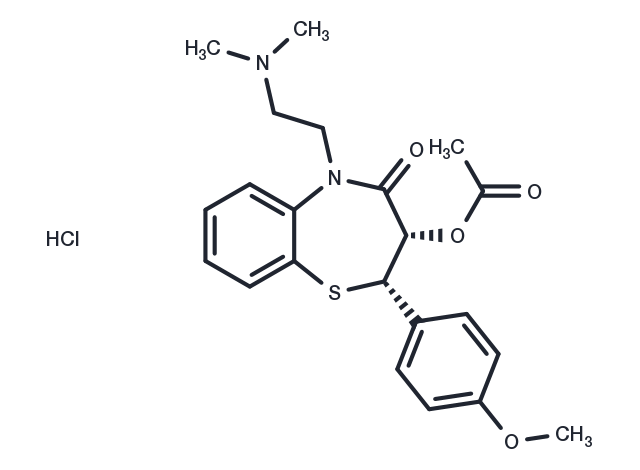Powder: -20°C for 3 years | In solvent: -80°C for 1 year


Diltiazem hydrochloride (RG 83606 HCl) is a benzothiazepine calcium channel blocking agent with vasodilating action due to its antagonism of the actions of CALCIUM ion on membrane functions.

| Pack Size | Availability | Price/USD | Quantity |
|---|---|---|---|
| 500 mg | In stock | $ 46.00 | |
| 1 g | In stock | $ 53.00 | |
| 5 g | In stock | $ 119.00 |




| Description | Diltiazem hydrochloride (RG 83606 HCl) is a benzothiazepine calcium channel blocking agent with vasodilating action due to its antagonism of the actions of CALCIUM ion on membrane functions. |
| In vitro | Benzothiazepine Ca2+ antagonist diltiazem hydrochloride interacts with transmembrane segments IIIS6 and IVS6 in the α1 subunit of L-type Ca2+ channels[1]. Diltiazem causes a dose-dependent inhibiton of contractions as well as Ca2+ influx stimulated by alpha adrenoceptor activation and high-K+ depolarization. Diltiazem is roughly equally potent in inhibiting contractions induced by high-K+ and a low concentration of norepinephrine (NE)[2]. Diltiazem also inhibits the Na-dependent Ca-efflux from heart mitochondria. Both the (+)-optical isomers of the cis- and trans-forms of diltiazem inhibit Na-Ca exchange activity with comparable potency (IC50 of 10-20 μM)[3]. |
| In vivo | Diltiazem exhibits noncompetitive inhibition of calcium-induced contractions in depolarized rabbit aorta and lacks parallel effects between the removal of extracellular calcium ([Ca2+]ex) and its addition. It enhances cardiac microcirculation and function in hyperthyroid rat models, significantly reducing left ventricular fibrosis when combined with losartan (4.7±0.7%; P < 0.001). In spontaneously hypertensive rats, diltiazem lowers blood pressure and increases heart rate in a dose-dependent manner after intravenous administration (0.03--1 mg/kg) and through oral administration (100 mg/kg), demonstrating its therapeutic potential in hypertension management. |
| Synonyms | CRD-401, RG 83606 HCl, Diltiazem HCl |
| Molecular Weight | 450.98 |
| Formula | C22H27ClN2O4S |
| CAS No. | 33286-22-5 |
Powder: -20°C for 3 years | In solvent: -80°C for 1 year
H2O: 100 mg/mL (221.74 mM)
DMSO: 12.4 mg/mL (27.5 mM)
You can also refer to dose conversion for different animals. More
bottom
Please see Inhibitor Handling Instructions for more frequently ask questions. Topics include: how to prepare stock solutions, how to store products, and cautions on cell-based assays & animal experiments, etc.
Diltiazem hydrochloride 33286-22-5 Membrane transporter/Ion channel Metabolism Calcium Channel Inhibitor Diltiazem Ca channels CRD-401 inhibit RG 83606 HCl Diltiazem Hydrochloride CRD401 Ca2+ channels Diltiazem HCl CRD 401 inhibitor
